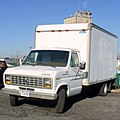Box body

A box body is a vehicle body with solid walls in the form of a closed box. The structure is usually firmly connected to the chassis. There are also exchangeable truck bodies, but one speaks here of a swap boxes or containers .
A box body usually consists of a ladder frame made of steel and stable side walls made of wood or aluminum , in some cases also made of plastic . Depending on the type of use, there are different types of case bodies, from simple plywood cases to variants made of aluminum or sandwich lightweight construction to insulated thermal cases. On trucks , the body is spatially separated from the driver's cab. In the case of smaller vans with box bodies, however, there are also variants with a passage to the driver's cab, for example in the case of delivery vehicles for the parcel service.
Special forms
Refrigerated box bodies (also called insulated or thermal boxes) are additionally insulated . For this purpose, the side walls, the floor and the ceiling are cast in a sandwich construction made of polyurethane foam and glass fiber reinforced plastic , usually with a reinforcement made of wood. Since the insulation of the refrigerated superstructures requires a greater wall thickness than with a conventional case, air-conditioned vehicles may exceed the maximum width of 2.55 m stipulated in Section 32 StVZO . They have a maximum width of 2.60 m if they are equipped for the transport of goods in temperature-controlled condition and their side walls including insulation are at least 45 mm thick.
Advantages and disadvantages
The advantages of a box extension include:
- Possibility of temperature-controlled transport for iso cases
- For certain goods, form-fitting load securing is possible due to the solid side walls
- Better protection of the load against the weather and theft than with flatbed trucks with tarpaulin
- Fixed structure enables the installation of special equipment such as shelving systems in parcel delivery vehicles, hanging devices for transporting clothes, etc.
- Cuboid-shaped interior facilitates individual expansion, compared to box vans with inclined or curved walls
But there are also disadvantages:
- Due to the higher dead weight, the payload of the vehicle is reduced compared to a structure with a simple flatbed and tarpaulin roof
- unsuitable for certain types of goods such as B. long steel, which is loaded by crane
- In most cases, side loading and unloading is also not possible (exception: folding wall case with side doors)
photos
Three-wheeled Piaggio Ape
literature
- Hermann Brähler, Jochen Graefenstein, Wolfgang Appel, Ulrich Dahlhaus, Thomas Esch: Commercial vehicle technology. Basics - Systems - Components, 2nd revised edition, Vieweg Verlag, Wiesbaden 2002, ISBN 978-3-663-05762-8 .
- Uwe Clausen: Handbook of traffic logistics. Springer Verlag Berlin Heidelberg GmbH, Berlin Heidelberg 1998, ISBN 978-3-662-07706-1 .
- Josef Epker: Trucks and Technology. Epjos Verlag, Wettringen, ISBN 978-3-9816513-0-0 .











